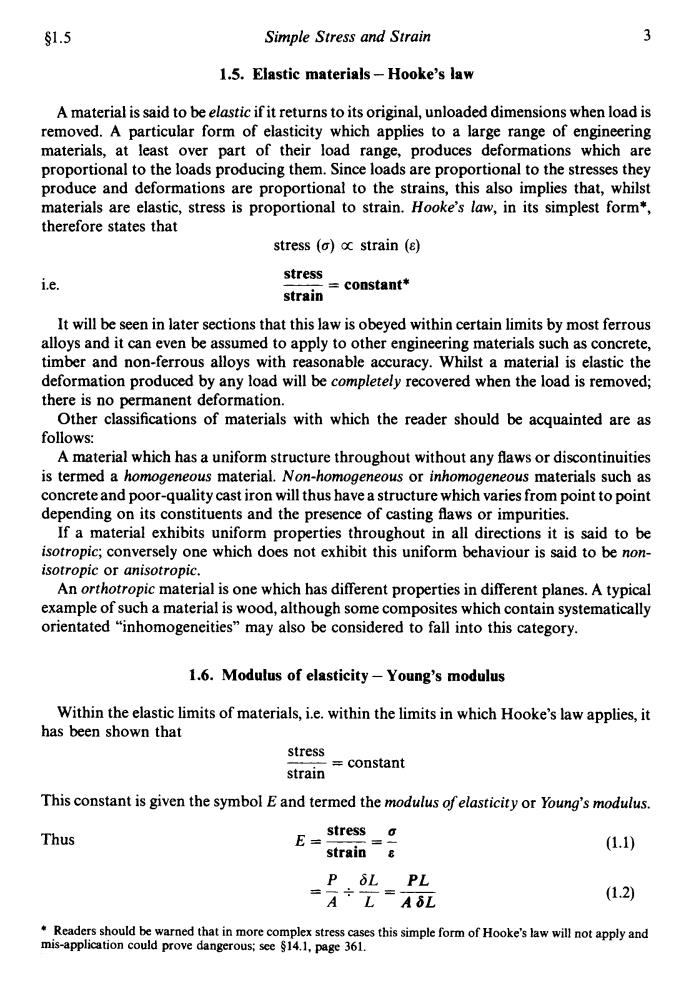正在加载图片...

s1.5 Simple Stress and Strain 3 1.5.Elastic materials-Hooke's law A material is said to be elastic if it returns to its original,unloaded dimensions when load is removed.A particular form of elasticity which applies to a large range of engineering materials,at least over part of their load range,produces deformations which are proportional to the loads producing them.Since loads are proportional to the stresses they produce and deformations are proportional to the strains,this also implies that,whilst materials are elastic,stress is proportional to strain.Hooke's law,in its simplest form*, therefore states that stress (o)oc strain (8) stress i.e. constant* strain It will be seen in later sections that this law is obeyed within certain limits by most ferrous alloys and it can even be assumed to apply to other engineering materials such as concrete, timber and non-ferrous alloys with reasonable accuracy.Whilst a material is elastic the deformation produced by any load will be completely recovered when the load is removed; there is no permanent deformation. Other classifications of materials with which the reader should be acquainted are as follows: A material which has a uniform structure throughout without any flaws or discontinuities is termed a homogeneous material.Non-homogeneous or inhomogeneous materials such as concrete and poor-quality cast iron will thus have a structure which varies from point to point depending on its constituents and the presence of casting flaws or impurities. If a material exhibits uniform properties throughout in all directions it is said to be isotropic;conversely one which does not exhibit this uniform behaviour is said to be non- isotropic or anisotropic. An orthotropic material is one which has different properties in different planes.A typical example of such a material is wood,although some composites which contain systematically orientated "inhomogeneities"may also be considered to fall into this category. 1.6.Modulus of elasticity-Young's modulus Within the elastic limits of materials,i.e.within the limits in which Hooke's law applies,it has been shown that stress constant strain This constant is given the symbol E and termed the modulus ofelasticity or Young's modulus. Thus stress o E= strain (1.1) P L PL FA÷D=A6L (1.2) Readers should be warned that in more complex stress cases this simple form of Hooke's law will not apply and mis-application could prove dangerous;see $14.1,page 361.$1.5 Simple Stress and Strain 3 1.5. Elastic materials - Hooke’s law A material is said to be elastic if it returns to its original, unloaded dimensions when load is removed. A particular form of elasticity which applies to a large range of engineering materials, at least over part of their load range, produces deformations which are proportional to the loads producing them. Since loads are proportional to the stresses they produce and deformations are proportional to the strains, this also implies that, whilst materials are elastic, stress is proportional to strain. Hooke’s law, in its simplest form*, therefore states that stress (a) a strain (E) i.e. stress strain -- - constant* It will be seen in later sections that this law is obeyed within certain limits by most ferrous alloys and it can even be assumed to apply to other engineering materials such as concrete, timber and non-ferrous alloys with reasonable accuracy. Whilst a material is elastic the deformation produced by any load will be completely recovered when the load is removed; there is no permanent deformation. Other classifications of materials with which the reader should be acquainted are as follows: A material which has a uniform structure throughout without any flaws or discontinuities is termed a homogeneous material. Non-homogeneous or inhomogeneous materials such as concrete and poor-quality cast iron will thus have a structure which varies from point to point depending on its constituents and the presence of casting flaws or impurities. If a material exhibits uniform properties throughout in all directions it is said to be isotropic; conversely one which does not exhibit this uniform behaviour is said to be nonisotropic or anisotropic. An orthotropic material is one which has different properties in different planes. A typical example of such a material is wood, although some composites which contain systematically orientated “inhomogeneities” may also be considered to fall into this category. 1.6. Modulus of elasticity - Young’s modulus Within the elastic limits of materials, i.e. within the limits in which Hooke’s law applies, it has been shown that stress strain -- - constant This constant is given the symbol E and termed the modulus of elasticity or Young’s modulus. Thus stress 0 strain E E=-- _- P 6L PL A’ L ASL =--I-- -- * Readers should be warned that in more complex stress cases this simple form of Hooke’s law will not apply and misapplication could prove dangerous; see 814.1, page 361